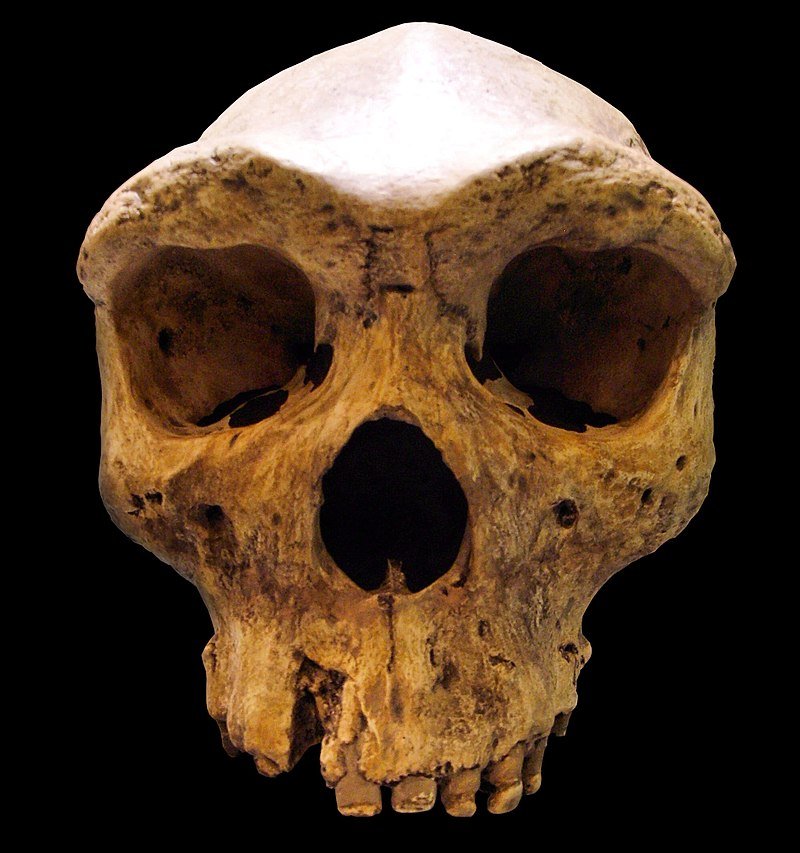The Incredible Human Part Five: Toothpick Use
As many of you know from reading posts on this site, tooth decay did not become a significant problem until we started farming 10,000 years ago. Neanderthals show a high prevalence of enamel wear, hypoplasia, tooth loss, periodontal disease, and abscesses attributed to eating course foods. Cavities, on the other hand, were much rarer. Only six cases of dental cavities (caries) have been reported among the approximately 1250 known Neanderthal teeth. Furthermore, from the presence of cavities in primates, it is obvious that natural sources of carbohydrates can produce cavities. Some researchers blame cooking for decay, but cavities exist in modern apes despite being mostly herbivorous with a raw diet based on only a few starchy tubers, if any. 1
Broken Hill Skull
The oldest evidence of tooth decay comes from a fossil found in 1921 in Broken Hill, Northern Rhodesia (Zambia), in a tooth from a human species that predates Neanderthals and modern humans. The species lived from 650,000 to 160,000 years ago. As I had mentioned, some researchers believe cavities arise from ingesting unprocessed carbohydrates, as evidenced by tooth decay in apes and other primates. But there is a uniquely human behavior that contributed to tooth decay in early humans. Some researchers believe the cavities began due to the use of toothpicks that are too hard and destroyed tooth structure. Damaged teeth are more susceptible to decay. 2 There is ample evidence of toothpick use.
The belief that we used toothpicks in ancient times stems from numerous fossil remains of humans that show grooves in teeth caused by toothpicks possibly made of bone, which can damage teeth. The toothpick-caused grooves between the teeth, called interproximal grooves, make it easier to develop cavities. 3 It is possible that unprocessed carbohydrates caused the decay, based on the evidence I mentioned earlier. Also, other things like smoking tobacco lead to decay. However, no evidence of smoking goes back that far. Current evidence places the earliest date at only 12,300 years ago. 4 Humans may have smoked back then, but the likelihood of the organic components of tobacco use preserving well is minuscule. Archeologists claim that they mostly find stones and bones almost exclusively. Tobacco and wooden pipes don’t readily preserve, and we did not use pottery until much more recently.
Toothbrushing may go back as far as tooth picking, but we may never know because brushes were probably made from frayed twigs that also don't preserve. The oldest evidence of tooth brushing is from about 5000 years ago in Egypt.
Primitive toothbrushes/toothpicks
The Leakey family has been at the forefront of human archeology for decades. One of their last finds at Olduvai Gorge was a tooth with an interproximal groove. The famous dental anthropologist Peter Unger looked at its interdental groove eighteen years later under an electron microscope and discovered tiny striations that could not be caused by chewing. See the image below. He concluded that the marks could only have been caused by the overuse of toothpicks made of hard materials like bone. He also drew a parallel between tool use and the introduction of meat to humans' diets. Ungar said toothpick use is one of the first lines of evidence from the hominid fossil record that shows our genus consuming significant amounts of meat in the ancient past. Tooth picking likely served to remove food, especially meat, but it caused visible damage. 5 To quote him, "Teeth are not well designed for eating meat, so our early ancestors had to use toothpicks." 6
Groove caused by toothpick Source: https://www.pnas.org/doi/full/10.1073/pnas.1316052110
My experience is that being on the carnivore diet; I use more toothpicks now that I only eat animal-based foods which have a significant impaction rate. The amazing part of Ungar's find is the age of the tooth. Mary Leakey and her colleagues at Olduvai helped date some of the earliest tooth-picking to ancestors of human beings, Homo erectus, dating back as far as 1.8 million years! Tooth picking also occurred in other human species, including Homo habilis, Homo neanderthalensis, and Homo heidelbergensis. 3
Some animals practice dental hygiene. For instance, canines chew sticks and bones that help clean their teeth. Sharks and other fish allow cleaner wrasse fish into their mouths to debride them of food and parasites. The actions just described, although amazing, constitute strategies that originated at the genetic level. They should not be construed as conscious behaviors specifically aimed at removing unwanted teeth deposits.
Cleaner Wrasse
So there you have it; toothpick use is a uniquely human activity. No guidelines exist from the American Dental Association on the use of toothpicks. They downplay devices that clean between teeth in favor of floss. However, if floss is unavailable or socially inappropriate, use a wooden toothpick by all means. Even foods that can't cause decay, like meat, if impacted, can still cause harm and disease to the gums. The recommendation to brush twice daily and floss once is very valid. Make sure the brush and floss are soft enough to cause no harm. I am not talking about toothpaste here. I am not a huge fan of some ingredients in ADA-approved toothpaste. ADA approval for these items is generally valid. Lastly, two dental check-ups per year are a must for most of us.




